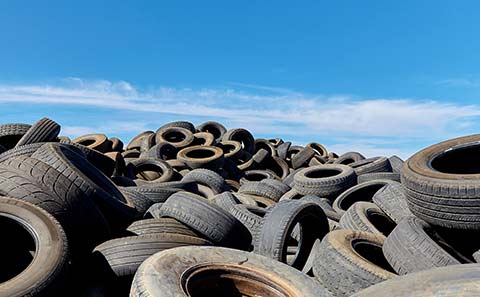If you’re considering a used car or SUV, don’t stop at mechanical inspections before you buy. Also take a good, long look at the tires.
The tires on a used vehicle can tell you an awful lot about the vehicle itself:

• Does the vehicle need an alignment?
• Has the vehicle been driven hard?
• Must the tires be replaced immediately because of their age, wear or dry rot?
• Does the vehicle require tires that will be too expensive for your budget?
Let’s take a look at these factors and how they may affect the deal and your ownership of the vehicle.
Alignment Issues
Uneven tire wear usually isn’t a big issue unless the vehicle has high mileage. Before 80,000 miles, uneven tire wear typically means an alignment is needed—or something as simple as improper inflation. If you have the vehicle checked by your mechanic before the deal—and you should invest that $60 to $100—he’ll see if bad alignment is causing the problems or something more expensive.
Other causes of uneven tire wear can be a chassis damaged by a crash, worn ball joints or worn tie roads.
If it’s merely an alignment, tie rods or ball joints, insist that the work becomes a condition of the deal. If the chassis is damaged, walk away.
See our blog for more on excess tire wear.
Hard Driving
Tires can hint at a previous owner’s driving habits. If the vehicle has a reputable brand and model of tire but the tires are worn at 20,000 miles or even sooner, it may be that the driver drove the vehicle hard. Abuse could include burning the tires while accelerating quickly from stoplights, track use or frequently cornering at high speeds. If an SUV or Wrangler’s tires have cuts or chunks missing from the tread, it could mean the vehicle was used off road on rugged trails.
You might think, “What’s the big deal?” How about a worn clutch, torque converter, brakes or shocks? They’re all pretty big deals that prematurely worn tires may foreshadow.
Old and/or Worn Tires

Tires wear out. It’s why Best Used Tires sells them and you buy them. If the tires simply have too little tread left, have worn within a reasonable time, and have worn evenly, make new tires a condition of the deal. If only two tires are worn, have the tires on that axle replaced.
Don’t just say, “Put new tires on and it’s a deal.” There are budget tires out there that are nearly worthless when new and certainly after 10,000 miles. They’re bad in rain, they’re bad in snow, they’re bad on dry pavement. But they’re cheap and new, so some dealers will put them on because they figure they can get away with it.
Make sure the tires you’re getting are comparable to the tires that were original to the car. If you’re replacing just two tires, insist that the new tires be identical to the two tires that are not yet worn out.
Always check the tires for dry rot, too, not just tread wear. Dry rot manifests itself in tiny cracks in the sidewalls. It often is a result of too much exposure to the ultra violet rays in sunlight, or just old age and weathering. If you see the evidence, insist on replacements, even if the tread appears to have significant life left.
If you can’t get new tires but the tires on the vehicle are legal and safe, at least for a while, you may want to pull the trigger on the deal. Remember, you can always put on quality used tires if your budget is tight and you need a car.
Tires and Your Budget
Don’t forget to consider what replacement tires will cost. Even if the vehicle doesn’t need tires now, it will in a year or two or, if you don’t drive it much, three. Can you afford tires identical to the tires on the car? If not, can you find satisfactorily performing replacements at an affordable price?

If the answer to either question is yes, you’re good to go. If the vehicle has specialty tires that would be out of your league, consider another vehicle—maybe the same model without a performance or sport option package, which often means smaller wheels and more affordable tires.
Check for a Spare
Look in the trunk to make sure the vehicle has a spare. If there’s a false floor that hides the spare’s storage area, lift it and inspect the tire. Make sure it shows no signs of deterioration and has significant tread let—in other words, that it will work as a spare. Check for a jack, too. If both or either are missing, ask that the dealer replace them. If he won’t, use their absence as a bargaining chip on the purchase price and replace them yourself.


